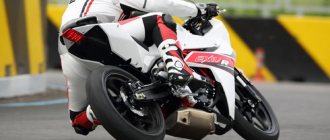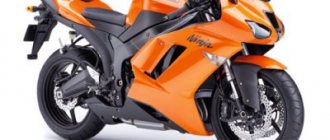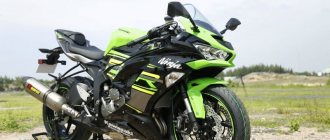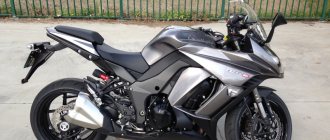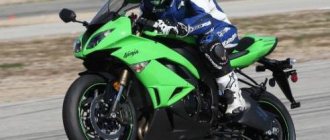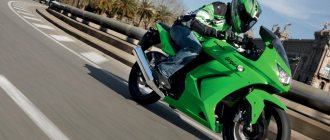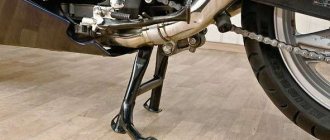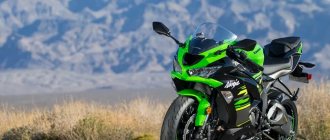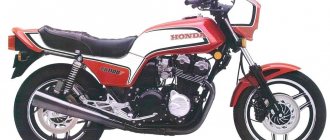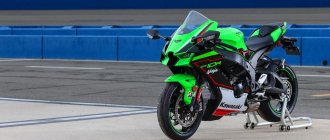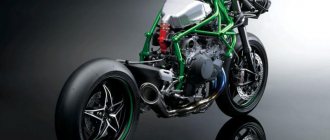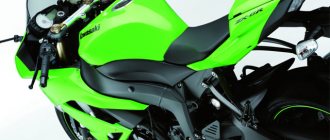Japanese motorcyclesKawasaki motorcycles
What do you think is Kawasaki's best-selling motorcycle model? Maybe you think this is the famous Kawasaki ZX-6R sportbike?
Or the acclaimed Kawasaki KLR650 enduro version? No, no and NO. The top seller was a motorcycle with a “two hundred and fifty cc” power unit.
This is the Kawasaki Ninja 250R - a motorcycle best suited for beginner motorcyclists. This is exactly how Kawasaki specialists position it. And it is this motorcycle that changes our understanding of this class.
Kawasaki Ninja 250 R review
If you look at the Kawasaki ninja 250R from the outside, it may seem that this is a 600cc version. The Ninja's design is in no way inferior to the design of its larger, larger brothers , whose appearance served as the basis for it.
And now it seems as aggressive and challenging as the ZX series motorcycles. Especially if the “250” nameplate is invisible.
The first Kawasaki Ninja 250R was produced in 1986, pointing other manufacturers in the right direction for the further progress of the motorcycle industry - towards road superbikes and touring motorcycles.
Which is quite far from its predecessors – huge outdated road mastodons. This year, two models of the Ninja family were released at once - the GPZ and GPX series. And, immediately, motorcycles hit the bestseller list.
Over the years since its release, the motorcycle has undergone many external changes and received a complete technical re-equipment.
What is the modern Kawasaki ninja 250R like?
conclusions
The Kawasaki Ninja 250 is the best option as a transhipment base for civilian motorcyclists, allowing them to understand the difference between a road bike or chopper with sports motorcycles.
The motorcycle is easy to ride due to its low weight.
The small volume of the internal combustion chamber causes weak acceleration, which, together with the mass of electronics, allows you to quickly get used to the bike . In this regard, the manufacturing company at the beginning of 2022 released a globally modified version, distinguished by a power of 39 horsepower, which replaced the old generation on the market along with the Ninja 300 model.
Motorcycle design
Viewed from the front, the design is defined as aggressive.
This is facilitated by the dual design of the head light elements.
The angular rearview mirrors, like the headlights, add to this aggressiveness.
The motorcycle and its components are covered almost completely with a plastic fairing with a large number of metal elements and sharp edges, which improves its aerodynamic qualities.
The front wheel fender and front fork fairing are made in the same style. The rear end, raised high above the wheel and with a pointed shape, also looks very sporty.
The rear two-seater, two-stage seat favorably improves the perception of the motorcycle and gives it a stylish look.
A large black muffler with a chrome tip seems to give the motorcycle extra power in appearance.
The instrument panel, modern and informative, is also clad in a fairing ending in a small windshield.
The instrument cluster includes a speedometer and tachometer in an analogue version with a white background and an indication unit with indicators for low pressure and high oil temperature, low fuel level and battery charge, low fuel level and air filter contamination.
The motorcycle comes in several color schemes:
- Green;
- Blue;
- Red;
- Black.
If you like 250cc motorcycles, pay attention to the Suzuki Bandit 250, whose characteristics are impressive, our article is about it.
A faithful friend has broken down, and the service is on the other side of town? Let's figure out the problem of transporting a motorcycle together.
Engine Kawasaki Ninja 250R
The motorcycle's powertrain is tuned to produce more torque at the expense of its peak power. Therefore, at speeds up to medium, the motorcycle has a good and reliable “pickup”.
During the modernization process, the engine's reliability was increased by introducing enlarged cylinder heads, strengthening the pistons in the piston pin area, and enlarging the piston rings. Optimization of the fuel combustion chamber increased operating efficiency. The evolution of the fuel system culminated with the introduction of the fuel injector.
Motorcycle transmission and chassis
The Ninja 250R is equipped with a six-speed gearbox with carefully selected ratios, which allows you to move comfortably both in the city cycle and on the country highway.
The rear wheel is driven by a chain. The front suspension of the motorcycle has a telescopic fork, the rear suspension has a Uni-Trak system with five-stage adjustment.
The brakes are equipped with discs of increased diameter. The wheels with a diameter of 17 inches contribute to good handling and comfort of the motorcycle.
Enlarged brake disc
The 2008 model has an improved braking system with increased lever sensitivity, allowing you to brake with just two fingers. Up front there is a larger 290mm petal disc (larger means more force applied). It's squeezed front and rear by new two-piston calipers. The brake disc is shaped like a flower (hence its name), rather than a circle like most motorcycles. This increases the efficiency of its work.
Specifications
| Parameter | Characteristic |
| Engine | |
| engine's type | in-line 4-stroke 2-cylinder, liquid cooling |
| Engine capacity | 249 cm³ |
| Bore/Stroke | 62.0 x 41.2 mm |
| Compression ratio | 11.6:1 |
| Valve/Intake System | DOHC, 8 valves |
| Maximum power | 23.5 kW (32 hp) at 11,000 rpm |
| Maximum torque | 21.7 Nm (2.21 kg/m) at 10,000 rpm |
| Fuel Delivery/Carburetor | Keihin CVK30 x 2 |
| Fuel injection | O28mm x 2 (Keihin) dual throttle bodies |
| Ignition | Digital |
| Starting system | Electric |
| Lubrication system | Forced lubrication, crankcase |
| Transmission | |
| Transmission type | 6-speed, reverse |
| Final drive | Chain |
| Main gear ratio | 3.087 (71/23) |
| Gear ratio: 1st gear | 2.600 (39/15) |
| Gear ratio: 2nd gear | 1.789 (34/19) |
| Gear ratio: 3rd gear | 1.409 (31/22) |
| Gear ratio: 4th gear | 1.160 (29/25) |
| Gear ratio: 5th gear | 1.000 (27/27) |
| Gear ratio: 6th gear | 0.893 (25/28) |
| Final gear ratio | 3.214 (45/14) |
| Clutch | Multi-disc, oil bath, manual control |
| Chassis | |
| Frame type | diamond-shaped, steel |
| Fork Rake / Reach | 26° / 83 mm |
| Suspension, front | Telescopic fork 37 mm long |
| Suspension, rear | Uni-Trak, lower control arm, gas shock absorber, 5-way adjustable |
| Front suspension travel | 120 mm |
| Rear suspension travel | 130 mm |
| Tire, front wheel | 110/70-17 M/C (54S) |
| Tire, rear wheel | 130/70-17 M/C (62S) |
| Brakes, front | One petal brake disc with a diameter of 290mm. One 2-piston balanced caliper |
| Brakes, rear | One petal disc with a diameter of 220mm. 2-piston caliper |
| Steering angle | left / right 35° / 35° |
| General characteristics | |
| dimensions | (Length / Width / Height) 2,080 mm x 710 mm x 1,115 mm |
| Wheelbase | 1,390 mm |
| Ground clearance | 135 mm |
| Seat height | 780 mm |
| Volume of the tank | 18 liters |
| Net weight | 151 kg |
| Maximum speed | 180 km/h |
Safety and convenience
First of all, the skills of a biker allow you to ensure proper safety; regardless of the type of road surface, you must feel the road. Before racing fast, you should definitely get used to the brakes and grip. The Ninja motorcycle was able to achieve maximum stability on the road thanks to the presence of high-quality rubber, which holds the road even with a serious inclination. The diameter of the wheels is 17 inches, the front tire is 110/70, the rear is thicker - 130/70.
After a few kilometers you will feel the brakes more accurately; both wheels are equipped with petal disc brakes, but with different diameters. Also, both brakes are equipped with a 2-piston caliper. But many people point out that the brakes are disadvantageous due to the fact that they do not have adjustable brake and clutch releases. A real Japanese sport should be equipped with such a system.
Motorcycle cost
The high level of sales of the motorcycle was due not only to its stylish design and interesting technical characteristics, but also to the company’s affordable pricing policy.
The cost of the model for a long time remained within three and a half thousand dollars. Successive modernizations of the motorcycle gradually increased its cost and, now, the price of the new Kawasaki ninja 250R in Russia is about 240,000 rubles.
The price of Kawasaki Ninja 250 R on the secondary market starts from 100,000 rubles for 2008-2009 models, up to 230,000 rubles for 2012 models.
It should be noted that the price is approximate and can easily be reduced with the right approach to buying a motorcycle . And the correct approach is a mandatory and, one might say, meticulous inspection of the vehicle.
It is recommended to check according to the following parameters:
- Inspection of the frame. The absence of changes in geometry, cracks, dents, and paint rebounds on the welds is checked.
- Front fork. Check that there is no fluid leakage when the fork moves vertically.
- Chain drive. The degree of chain elongation from normal parameters is checked.
- Brake discs. The wear of the discs is checked, which should not have a pronounced decrease in thickness.
- Tire condition. If the rear tire is worn more in the center than on the edges, this means that the owner is a fan of hard starts, which, in turn, may indicate that the motorcycle may have increased wear on the engine and transmission.
- Availability of technical fluids. The level and condition of working fluids in the engine, cooling system, and brake system are checked.
- Engine. It is checked in start-up mode, warm-up mode and in a warm-up state. There should be no obvious soot or oil discharge from the exhaust pipe.
- Radiator. The integrity of the radiator and the uniformity of its heating are checked.
- Electrical equipment. The functionality of all electrical appliances is checked and the brightness of the headlights does not change when the engine speed changes.
You can read more about the inspection before purchasing your first motorcycle in our article: “Which motorcycle to choose for a beginner.”
The Kawasaki ninja 250R motorcycle is not the same Ninja of 1986, but its popularity has not diminished at all, and still remains the blue dream of many motorcycle lovers. This bright, attractive example of modern motorcycle technology can introduce a beginner to the grandiose action of circuit racing, and simply attract the attention of others.
Is it necessary to have MTPL insurance for trailers? The answer to this question is in our review article.
400 cc representative of the Honda motorcycle family: . Brief overview and technical specifications.
Short flight
The lower rake angle of 26°C makes steering and cornering easier. The shorter the reach, the easier it is to make tight turns. According to reviews from drivers who drove on narrow roads, it was easy to turn around on them if you looked in the direction of the intended movement and did not put your feet down. The motorcycle also received new 6-spoke 17-inch wheels (instead of 16”) with low-profile tires, providing greater stability. In addition, this size is more common and allows you to find tires to suit your taste.
Photo gallery
This motorcycle brought many modern riders into the sport and continues to this day. The low cost, outstanding characteristics of the motorcycle and its versatility in terms of the possibility of use, both in sports and in everyday life, help its owner determine his preferences. We present to your attention a small photo selection of the Kawasaki ninja 250R.
Transmission
The clutch is a little stiffer than you'd expect from an entry-level bike, but that's certainly not a deal-breaker. Once you get going, the updated 6-speed transmission shifts smoothly and there's never any trouble finding neutral. All Kawasaki motorcycles are equipped with the manufacturer’s proprietary technology, which allows you to do this without difficulty. A green light on the instrument panel confirms when the transmission is in neutral.
Riding experience
According to owners, the motorcycle's two-cylinder engine chugs a little and its squat stance is a bit lazy if the rider is used to an aggressive riding style. However, it allows you to easily adjust the acceleration and speed. If you pull the clutch and engage the gear, you will notice that the lever has a long stroke. The engine revs gradually and becomes noisy around halfway to its maximum 13,000 rpm. Acceleration can be brisk enough to keep up with traffic or merge onto the highway, but you should keep the engine at maximum power level. If you change gear too early, you may miss the optimal rpm to achieve good acceleration.
The low weight of the motorcycle makes it easy to maneuver, and changing direction is done with minimal effort. If you keep the revs high, the Ninja 250 will be a pleasant ride on winding roads. The transmission behaves well and shifts with positive feedback most of the time, although at times it falls into false neutral between the two. The green neutral indicator sometimes does not light up. The brakes are much better and get pretty good reviews. Thanks to its light weight and maneuverability, riding the Kawasaki 250 Ninja sportbike is a fun and rewarding experience that will allow beginners to easily master riding techniques and more experienced riders to hone their basic skills.
